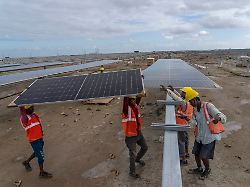Over 500 square kilometers in size
India is building the world’s largest power plant
March 20, 2024, 5:33 p.m
Listen to article
This audio version was artificially generated. More info | Send feedback
The world’s largest solar and wind farm is to be built in an Indian salt desert. This could supply millions of households in the country with electricity in just a few years. The project has gigantic dimensions.
The Indian Adani Group is building what it claims is the largest renewable energy power plant in the world. This is said to be over 500 square kilometers in size, which is five times the size of the French capital Paris, reports US broadcaster CNN.
In the so-called Khavda Renewable Energy Park, which is being built in the salt desert on the border with Pakistan, the company is investing around 20 billion US dollars in solar and wind turbines. “Such a large area, a region that is so unpolluted, there is no wildlife, there is no vegetation, there is no habitation. There is no better alternative use of this land,” said Sagar Adani, managing director of Adani, which is responsible for the project Green Energy Limited (AGEL) told CNN.
Adani is the nephew of Gautam Adani, who is one of the 20 wealthiest people in the world according to Forbes with a fortune of almost $80 billion. The billionaire made his fortune, among other things, as an importer of coal. Last year, the Adani Group came under pressure due to allegations of price manipulation and balance sheet falsification. The company denied the allegations, but its share price has since collapsed by half.
Company wants to invest 100 billion dollars
Now, according to CNN, the company plans to invest a total of $100 billion in renewable energy over the next decade. When completed, the Renewable Energy Park could power up to 16 million Indian households. The project’s success is seen as crucial to India’s efforts to reduce pollution and meet its climate goals while meeting the growing energy needs of the world’s most populous nation and fast-growing economy. Coal currently still accounts for 70 percent of the electricity generated by India.
In 2021, Indian Prime Minister Narendra Modi declared that India wants to reduce its CO2 emissions to net zero by 2070. The government had set a goal of achieving 500 gigawatts (GW) of non-fossil power generation capacity by 2030. AGEL, the country’s largest renewable energy company, aims to provide at least nine percent of that, with nearly 30 GW could be generated from Khavda Park in the Indian state of Gujarat alone.
